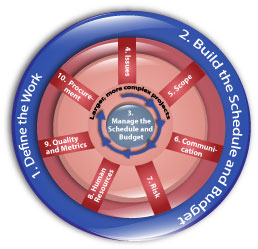![]()
5.0 Manage Scope
It is said that the only constant in the world is “change”. You can make perfect plans, but they cannot account for every potential change that may occur. The longer your project, the more likely you will be dealing with changes. This is one reason why the TenStep process recognizes that the initial definition (step 1) and planning (step 2) processes do not have to be perfect. You and your team need to do the best job you can with what you know at the time. That is good enough. After that you need to manage the changes.

High-level process flow
Scope Change (5.0.P2)
Scope is the term used to describe the totality of the work and the overall boundaries of the project. Scope is used to define what the project will deliver and what it will not deliver.
If you look at the reasons that projects fail, it is usually the result of two problems.
-
Lack of planning to sufficiently understand the nature of the project.
-
A lack of scope change management. Even if the project manager did a good job of defining scope, the hard part comes in having to manage the project within that agreed-upon scope.
The purpose of scope change management is to protect the viability of the approved Project Charter and the approved business requirements. In other words, the Project Charter defines the overall scope of the project, and the business requirements define the deliverables in detail. The project team committed to a deadline and budget based on this high-level and detailed scope. If the deliverables change during the project (and usually this means that the sponsor wants additional items), the estimates for cost, effort and duration may no longer be valid. If the sponsor agrees to include the new work into the project scope, the project manager has the right to expect that the current budget and deadline will be modified (usually increased) to reflect this additional work. This new estimated cost, effort and duration now become the approved target.
Sometimes the project manager thinks that scope management means having to tell the sponsor ‘no’. That makes the project manager nervous and uncomfortable.
However, the good news is that managing scope is all about getting the sponsor to make the decisions that will result in changes to project scope.
This is very important. Few customers can see and express every requirement up-front. Therefore, there are usually changes that need to be introduced during the project. These changes may be very necessary for the solution and there may be valid business reasons why they should be included. The project manager and project team must recognize when these changes are requested. Then they must follow a predefined scope change process. This process ultimately brings the appropriate information to the project sponsor and allows the sponsor to decide if the modification should be approved based on the business value and the impact to the project in terms of cost and schedule.
![]() 5.0.1
The Nature of Scope
5.0.1
The Nature of Scope
![]() 5.1 Manage
Scope / Process
5.1 Manage
Scope / Process
![]() 5.2 Manage
Scope / Techniques
5.2 Manage
Scope / Techniques
![]() 5.3 Manage
Scope / Quick Reference
5.3 Manage
Scope / Quick Reference
![]() Manage Scope /
Example
Manage Scope /
Example
[Previous - Manage Issues / Example] [Next - 5.0.1 The Nature of Scope]

